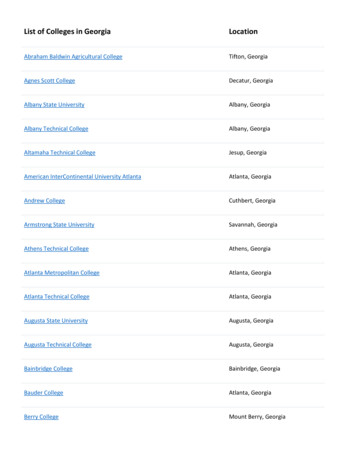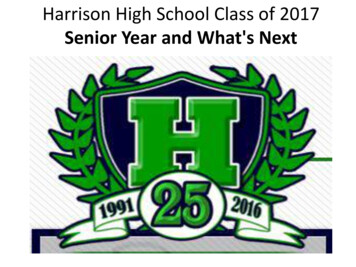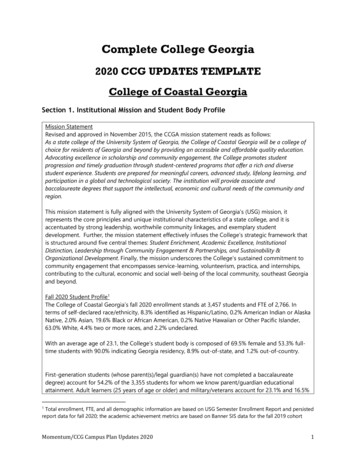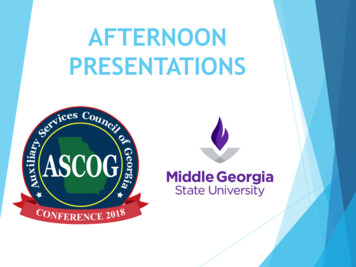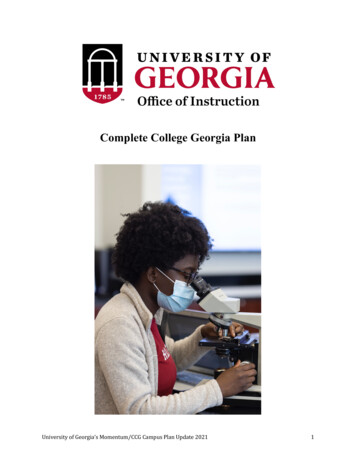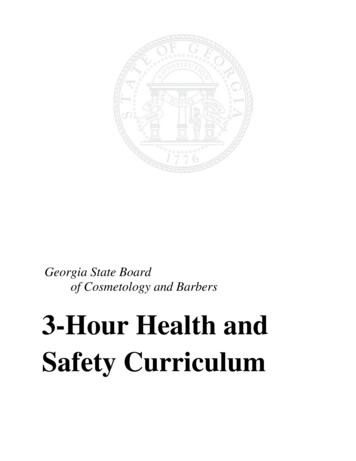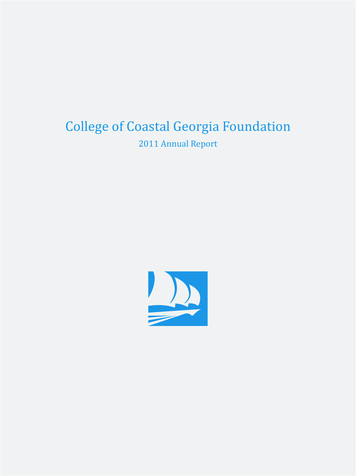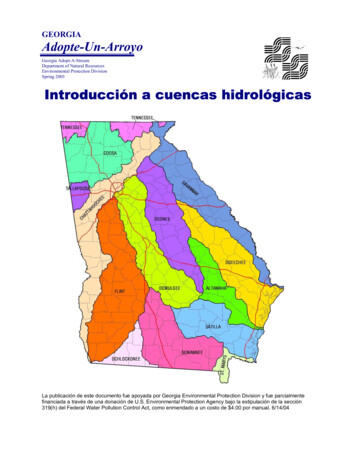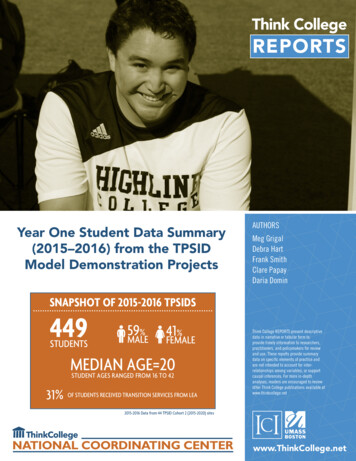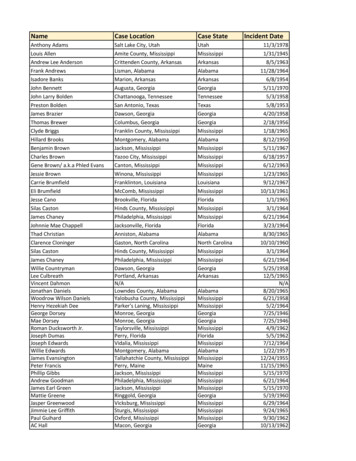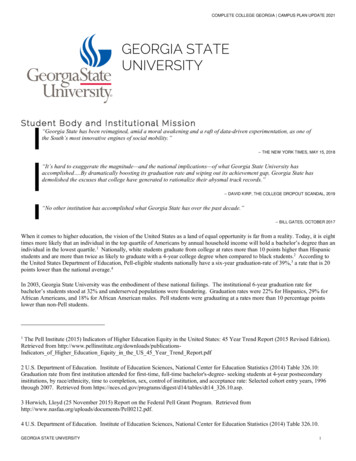
Transcription
COMPLETE COLLEGE GEORGIA CAMPUS PLAN UPDATE 2021GEORGIA STATEUNIVERSITYS t u de n t B o dy a n d I n s t i t u t i o n a l M i s s i o n“Georgia State has been reimagined, amid a moral awakening and a raft of data-driven experimentation, as one ofthe South’s most innovative engines of social mobility.”-- THE NEW YORK TIMES, MAY 15, 2018“It’s hard to exaggerate the magnitude—and the national implications—of what Georgia State University hasaccomplished .By dramatically boosting its graduation rate and wiping out its achievement gap, Georgia State hasdemolished the excuses that college have generated to rationalize their abysmal track records.”-- DAVID KIRP, THE COLLEGE DROPOUT SCANDAL, 2019“No other institution has accomplished what Georgia State has over the past decade.”-- BILL GATES, OCTOBER 2017When it comes to higher education, the vision of the United States as a land of equal opportunity is far from a reality. Today, it is eighttimes more likely that an individual in the top quartile of Americans by annual household income will hold a bachelor’s degree than anindividual in the lowest quartile.1 Nationally, white students graduate from college at rates more than 10 points higher than Hispanicstudents and are more than twice as likely to graduate with a 4-year college degree when compared to black students.2 According tothe United States Department of Education, Pell-eligible students nationally have a six-year graduation-rate of 39%,3 a rate that is 20points lower than the national average.4In 2003, Georgia State University was the embodiment of these national failings. The institutional 6-year graduation rate forbachelor’s students stood at 32% and underserved populations were foundering. Graduation rates were 22% for Hispanics, 29% forAfrican Americans, and 18% for African American males. Pell students were graduating at a rates more than 10 percentage pointslower than non-Pell students.1The Pell Institute (2015) Indicators of Higher Education Equity in the United States: 45 Year Trend Report (2015 Revised Edition).Retrieved from sIndicators of Higher Education Equity in the US 45 Year Trend Report.pdf2 U.S. Department of Education. Institute of Education Sciences, National Center for Education Statistics (2014) Table 326.10:Graduation rate from first institution attended for first-time, full-time bachelor's-degree- seeking students at 4-year postsecondaryinstitutions, by race/ethnicity, time to completion, sex, control of institution, and acceptance rate: Selected cohort entry years, 1996through 2007. Retrieved from 4 326.10.asp.3 Horwich, Lloyd (25 November 2015) Report on the Federal Pell Grant Program. Retrieved 12.pdf.4 U.S. Department of Education. Institute of Education Sciences, National Center for Education Statistics (2014) Table 326.10.GEORGIA STATE UNIVERSITY1
COMPLETE COLLEGE GEORGIA CAMPUS PLAN UPDATE 2021Rising G raduation RatesToday, thanks to a campus-wide commitment to student success and more than a dozen innovative, scaled initiatives, Georgia State’sequity gaps are gone. The institutional graduation rate for bachelor’s-degree seeking students has improved by 24 points—among thelargest increases in the nation over this period (See Appendix, Chart 1).5 Rates are up 35 points for Hispanics (to 57%), and 32 pointsfor African Americans (to 57%). Pell-eligible students currently represent 55% of Georgia State University’s undergraduate studentpopulation and have consistently graduated at or above the rate of non-Pell students (Chart 2). In fact, over the past six years, AfricanAmerican, Hispanic, and Pell-eligible students have, on average, all graduated from Georgia State at or above the rates of the studentbody overall—an all-but unprecedented accomplishment for a large public university. In short, race, ethnicity and income level are nolonger predictors of success at Georgia State. Even amid the COVID-19 pandemic, Georgia State students continue to excel, and theuniversity set new records for both its bachelor’s (56%) and associate (24%) degree graduation rates this past year. Tracking thesesame cohorts using National Student Clearinghouse data, 63% of associate-degree students graduate or are retained after threeyears, and 70% of bachelor’s students graduate and 78% graduate or are retained after six years. All of these rates are newhighs for the university.Record Numbers of Degrees AwardedGeorgia State also continues to set new records for degrees conferred. For the third consecutive year, the university awarded morethan 10,000 degrees, this year including a record of 7,758 undergraduate degrees (representing an 84% increase since 2010) (Chart3).The university established new records for total bachelor’s degrees awarded (5,422) as well as degrees awarded to Hispanic students(654, up 124% since 2010) and Asian students (913, up 80% since 2010) (Chart 4). Georgia State now awards more bachelor’sdegrees annually to African American, Hispanic, first generation, and Pell students than any other university in Georgia. In fact, fiveyears ago Georgia State University became the first institution in U.S. history to award more than 2,000 Bachelor’s degrees to AfricanAmerican students in a single year, a metric it has matched every year since (with 2,213 awarded this past year). No other college oruniversity in the U.S. has done so even once. According to Diverse Issues in Higher Education, for the seventh consecutive yearGeorgia State conferred more bachelor’s degrees to African Americans than any other non-profit college or university in the UnitedStates (Chart 6). Georgia State is also ranked first nationally in the number of bachelor’s degrees conferred to African Americans in anumber of specific disciplines: biology, finance, foreign languages, history, marketing, psychology, and the social sciences.Importantly, students are succeeding in some of the most challenging majors at Georgia State. Over the past decade, the number ofbachelor’s degrees awarded in STEM fields has increased by 155% overall, 158% for African American students, 216% for AfricanAmerican males, and 406% for Hispanic students (Chart 5).Perimeter CollegeThe news may be even better at Perimeter College, Georgia State’s associate-degree-granting college that enrolls more than 16,000students. Consolidation between Georgia State University and Perimeter College was finalized less than six years ago. Since then, thePerimeter 3-year graduation rate has almost quadrupled, rising from 6.5% to 24% (Chart 8). Equally encouragingly, as is the casefor bachelor’s students, equity gaps based on race, ethnicity and income level have largely been eliminated. In 2020 for the first time,African American, Hispanic and Pell students all graduated from Perimeter College at rates at or above those of the student bodyoverall. As recently as 2015, white students were graduating from Perimeter at rates more than two-and-a-half times the rate ofAfrican American students. In 2020, both white and African American students graduated at the same rate—exceptional progress insuch a short period of time. While the pandemic has disproportionately impacted Perimeter’s low-income and African Americanstudents, reopening some gaps in 2021, the fact is that Pell students and African Americans are graduating at rates five times higherthan they were prior to consolidation. The elimination of equity gaps based on race, ethnicity and income level has been a distinctiveand much-discussed accomplishment of Georgia State’s Atlanta campus, and the rapid progress in this area at Perimeter College lendscredence to the view that Georgia State’s unique data-based, proactive and systematic approach to student success—an approach nowbeing implemented at Perimeter—helps level the playing field for students from diverse backgrounds.According to The Chronicle of Higher Education (January 2020), 83% of Perimeter students now graduate, are retained, and/orsuccessfully transfer to four-year institutions within three years of first enrollment, ranking Perimeter College 20 th in the nation(among 2,000 community colleges ranked). Despite steep declines in Perimeter College overall enrollments in the years leading upto consolidation and new declines brought on by the COVID-19 pandemic, associate degree conferrals also have increased markedly,with 2,336 degrees awarded in 2020-21—representing an 25% increase since consolidation (Chart 9). Perimeter College now ranks5 All charts can be found in the Appendix.GEORGIA STATE UNIVERSITY2
COMPLETE COLLEGE GEORGIA CAMPUS PLAN UPDATE 202115th in the nation for the number of associate degrees awarded to African Americans annually.6 There is still much work to be done atPerimeter College, but the results already have been transformative.A National ModelA core part of Georgia State’s mission is to serve all students in Georgia. As such, the most foundational principle guiding ourstudent-success efforts has been a pledge to improve student outcomes through inclusion rather exclusion. In the 2011 Georgia StateUniversity Strategic Plan, we committed to increasing the number of underrepresented, first-generation and Pell students enrolled andto significantly improving graduation rates for all groups while eliminating equity gaps. The consolidation with Perimeter College,with its thousands of students who fall into federal at-risk categories, is one example of this deep commitment to inclusion. We alsocommitted to achieving improved outcomes for our students not merely while they are at Georgia State but in their lives and careersafter graduation.Over the past six years, Georgia State University’s student-success accomplishments have been the subject of growing levels ofnational attention. Highlights include: In December 2014, former President Barack Obama highlighted the exemplary work being done at Georgia State Universityto assist students through its innovative Panther Retention Grant program in his address at White House College OpportunityDay.7In 2014, Georgia State received the inaugural national Award for Student Success from the Association of Public and LandGrant Universities (APLU), and in 2015 it received the second-ever Institutional Transformation Award from the AmericanCouncil on Education (ACE). Both selection committees focused on Georgia State’s exceptional progress in student successand its elimination of equity gaps.In August 2015, Georgia State was invited to provide expert testimony on strategies for helping low-income students succeedbefore the Committee on Health, Education, Labor and Pension of the U. S. Senate.In July 2017, Bill Gates made a half-day visit to campus specifically to learn more about Georgia State’s innovative use ofdata and technology to transform outcomes for low-income students.Between 2018 and 2021, the Brookings Institution, Harvard’s CLIMB initiative, and US News and World Report releasedreports placing Georgia State among the top 1% of institutions in the nation for “social mobility”—helping students movefrom low-income status at matriculation to upper-income status as alumni.In spring 2018, The New York Times, in a feature article, highlighted Georgia State’s status as conferring the most degrees toAfrican Americans in the country and labeled the university “an engine of social mobility,” while the Harvard BusinessReview and NPR’s “The Hidden Brain” both chronicled the impact of Georgia State’s groundbreaking work using an A.I.enhanced chatbot to reduce summer melt.Georgia State’s student-success efforts became the subject of a feature-length documentary, Unlikely (2018), and an awardwinning book by Andrew Gumbel, Won’t Lose This Dream: How An Upstart Urban University Changed the Rules of aBroken System (2020).In fall 2021, U.S. News and World Report ranked Georgia State 1st in the nation for its Commitment to UndergraduateTeaching among all public universities (and 2nd overall, just ahead of Princeton) and as the 2nd Most Innovative University inthe nation (behind only ASU). Georgia State ranked 10th in the nation for Social Mobility and 11th for Diversity. GeorgiaState’s First-Year Experience and Learning Communities were each ranked 5 th in the nation.Motivated by a desire to make an impact not only in the lives of its own students but also in the lives of students nation-wide, GeorgiaState University has made a conscious and significant commitment of time and resources to share with others the lessons that we havelearned. Over the past several years, Georgia State has hosted teams of administrators and faculty members from more than 500colleges and universities enrolling 3 million students, all seeking to learn more about our student-success programs. Visitingcampuses have included almost every university in the University System of Georgia (USG), institutions from forty-seven U.S. states,as well as universities and national governing boards from the Netherlands, Great Britain, Bavaria, Georgia, Australia, Colombia,Hong Kong, South Korea, China, New Zealand, and South Africa. Major national organizations—including Achieving the Dream, theAmerican Association of State Colleges and Universities (AASCU), the Association of Public and Land Grant Universities (APLU),6Diverse Issues in Higher Education, August egreeProducers2017.php?dtsearch &dtrace &dtmajor &dtschool Georgia StateUniversity\-Perimeter College&dtstate &dtpage 07 President Barack Obama (4 December 2014) Remarks by the President at College Opportunity Summit. Retrieved mit.GEORGIA STATE UNIVERSITY3
COMPLETE COLLEGE GEORGIA CAMPUS PLAN UPDATE 2021the American Council on Education (ACE), Complete College America, and the U.S. Department of Education—have also turned toGeorgia State for its expertise in the area.In order to better support this dissemination work, as well as to incubate the next-generation of student-success innovations, GeorgiaState University established the National Institute of Student Success (NISS) in October 2020. In its first year, the NISS is alreadydelivering diagnostic and coaching services to more than two-dozen campuses nationally, including six in the state of Georgia.S T U D E N T S U C C E S S G O A L S AN D P R A C T I C E SStudent Success GoalsThe central goal that we have set for our undergraduate success efforts is highly ambitious, but the words were chosen carefully:Georgia State will “become a national model for undergraduate education by demonstrating that students from all backgroundscan achieve academic and career success at high rates.”8In 2011, Georgia State University committed to reach a graduation rate for bachelor’s-degree-seeking students of 52% by 2016 and60% by 2021.9 We also committed to conferring 2,500 more degrees annually than we did in 2010 and to eliminating all significantequity gaps between student populations. More recently, we committed to doubling the graduation rate of our new associate-degreeseeking students from the 2014 baseline over a five-year period.On the surface, attaining these goals seems implausible. Georgia State’s demographic trends—characterized in recent years by hugeincreases in the enrollments of students from underserved populations—typically would project a steep decline in student outcomes.Georgia State University, though, has been able to make dramatic gains towards its success targets even as the student body hasbecome far more diverse and less financially secure.The 2011 Strategic Plan also outlined key strategies to achieve these goals. We made a commitment to overhaul our advising system,to track every student daily with the use of predictive analytics and to intervene with students who are at risk in a proactive fashion, toexpand existing high-impact programs such as freshman learning communities and Keep Hope Alive, to raise more scholarshipdollars, to pilot and scale innovative new types of financial interventions, and to open a new Student Success Center. After the launchof the strategic plan, we launched additional programs such as the Success Academy, meta-majors, Panther Retention Grants, Collegeto Career, and an AI-enhanced chatbot to guide students through administrative and academic processesThe strategies have worked. Since the launch of Georgia State University’s 2011 Strategic Plan, each of the new programs outlined inthe Strategic Plan has been successfully implemented—and the new Student Success Center building will open in 2024. Ourinstitutional six-year graduation rate for bachelor’s-degree-seeking students has increased by 8 percentage points from 48% to 56%,while Georgia State’s cross-institutional six-year graduation rate this year reached a record 70%. It is important to note that, due tofrequent changes in jobs and economic circumstances, low-income and first-generation students and their families transfer morefrequently than do middle- and upper-income college students. This phenomenon significantly impacts Georgia State’s institutionalgraduation rate. When including Georgia State students who transfer to and graduate from other institutions (with the vast majoritydoing so from other schools within the University System of Georgia), the six-year bachelor’s graduation rate reached 70% in2021; and the percent of students who either earned a degree or were still actively enrolled reached 78%. The four-year graduation ratehas improved even more dramatically, with a 14-percentage-point increase, from 21% to 35%, between 2010 and 2020 (Charts 1, 2,12).The news is equally positive for Perimeter College. In the short time since consolidation was announced, the graduation rate forassociate-degree-seeking students at Perimeter College has more than tripled, moving from 6.5% in 2015 to 24% in 2021—farexceeding the strategic goal of doubling the rate by 2021. Just an impressively, as previously happened at the Atlanta campus, equitygaps based on race, ethnicity and income level have been closed at Perimeter College. The year prior to consolidation, white studentswere graduating from Perimeter at rates two-and-a-half times those for African Americans. By 2020, white and African Americanstudents are graduating at the same rates (Chart 7). 83% of Perimeter students are now graduating, successfully transferring, or are8Georgia State University (2012). Strategic Plan 2011-2016/21. Retrieved fromhttp://strategic.gsu.edu/files/2012/09/GSU Strategic Plan 2016-2.pdf9 Georgia State University (2012) College Completion Plan 2012: A University-wide Plan for Student Success (The Implementationof Goal 1 of the GSU Strategic Plan). Retrieved from iles/2013/09/GSU College Completion Plan 09-06-12.pdfGEORGIA STATE UNIVERSITY4
COMPLETE COLLEGE GEORGIA CAMPUS PLAN UPDATE 2021still enrolled after three years—a rate that ranks Perimeter College 20th among more than 2,000 community colleges nationallyaccording to The Chronicle of Higher Education (January 2020).10A record 7,758 undergraduate degrees were conferred by Georgia State University during the 2020-2021 academic year, representinga 3,534-degree increase (84%) over the baseline year of 2011 (Chart 3). The total now far exceeds the Strategic Plan’s target toincrease undergraduate degrees awarded by 2,500 annually by 2021. The number of degrees awarded by Perimeter College reached2,336 (Chart 9).Despite the fact that no major Georgia State initiative is targeted by race, ethnicity or income level, the gains have been greatest forstudents from underserved backgrounds. In recent years, Georgia State University has conferred record numbers of bachelor’sdegrees to Pell-eligible, first generation, African American, and Hispanic students (Chart 4). Since the 2010-2011 academic year, thenumber of bachelor’s degrees conferred to Pell students has grown by 48%, conferrals to African American students have increased by58%, and degrees awarded to Hispanic students have grown by 115% 11. Time to degree is down markedly—by almost a full semesterper student since 2011—saving the graduating class of 2021 approximately 21 million in tuition and fees compared to theircolleagues just five years earlier (Chart 11).Georgia State’s combination of large enrollment increases of students from underserved backgrounds and significantly risinggraduation rates confounds the conventional wisdom. How has Georgia State accomplished these unprecedented gains?HIGH IMPACT STRATEGIESGeorgia State’s student-success strategy has been innovative and data-informed. We have not created programs targeted at studentsby their race, ethnicity, first-generation status, or income level. Rather, we have used data to identity problems impacting largenumbers of Georgia State students, and we have changed the way the institution supports all students. Here are Georgia State’s tenmost impactful strategies:1. GPS AdvisingHigh-impactstrategySummary ofActivities andLessonsLearnedUse predictive analytics and a system of more than 800 data-based alerts to track all undergraduatesdaily. Create a structure of trained academic advisors to monitor the alerts and respond with timely,proactive advice to students at scale.The GPS System went fully live for bachelor’s students in August 2012. This past academic year,the system generated more than 135,000 individual meetings between advisors and students todiscuss specific alerts—all aimed at getting the student back on path to graduation. Approximately35,000 of the meetings were prompted by new alerts stemming from the COVID-19 pandemic, suchas tracking student log-ons to their online courses and advisors proactively reaching out whenstudents are not engaged. Since Georgia State went live with GPS Advising seven years ago,Georgia State four-year graduation rate for bachelor’s students has increased by 13 percentagepoints, equity gaps have been eliminated, and the average time to degree has decreased by morethan half a semester.In 2016, Georgia State University consolidated with Georgia Perimeter College. EDUCAUSE, withthe support of the Bill & Melinda Gates Foundation and the Leona M. and Harry B. HelmsleyCharitable Trust (the Helmsley Trust) and in partnership with Achieving the Dream (ATD),awarded Georgia State University a grant to facilitate our efforts to deploy our technology solutionand adapt our advising strategy in order to increase graduation rates for the 17,000 students seekingassociate degrees at Perimeter. The GPS platform launched at Perimeter in 2016-17 and theuniversity hired an additional 30 Perimeter academic advisors in support. Since consolidation, thethree-year graduation rate for associate-degree seeking students had increased by almost 16percentage points and equity gaps based on race, ethnicity and income level have been eliminated.10The metric used by The Chronicle of Higher Education here includes students who successfully transfer from Perimeter Collegewithin three years, whether or not they are actively enrolled at the transfer institution for the fall term three years after firstmatriculation. As reported elsewhere in this document, 68% of Perimeter’s 2018 freshmen had earned an Associate degree or wereactively enrolled during the Fall 2021 semester. This is a more rigorous metric.11Actual percent increases were much higher in these two categories, but we have controlled for the effects of the Universityimplementing more rigorous processes encouraging students to self-report their race and ethnicity.GEORGIA STATE UNIVERSITY5
COMPLETE COLLEGE GEORGIA CAMPUS PLAN UPDATE 2021BaselineStatusInterimMeasures ofProgressPrimaryContactsIn each context, 90% of the upfront costs have been directed to personnel, not technology. A 2019study by the Boston Consulting Group concludes that GPS Advising has produced a positive ROI,with programmatic costs of roughly 150 per students even larger increases in revenues fromstudent progression. Graduation Rates at Launch: 48% Bachelor level 6-year rate and 21% Bachelor level 4-yearrate (2011). 7% associate-level rate (2014) Degrees Conferred: in the 2013-2014 Academic Year: 4,155 bachelor’s degrees and 1,882 associate degrees (2014) The numbers we are achieving via the programs are exceptionally strong. Credit hours accumulated at the time of graduation have declined by an average of 9 credithours per graduating bachelor’s student since 2011 (Chart 11) Face-to face advising visits (bachelor’s associate) grew to a record 100,000 during the2019-2020 AY. Bachelor’s students switching majors after the first year of studies is down by 32%. Percent ofstudents in majors that fit their academic abilities (up by 13 points). Correlation between advisor visits and success markers (such as credit hours attempted andretention rates) (Chart 13) Face-to-face advising meetings with associate-degree students at Perimeter College increasedto 43,000 during the 2019-2020 academic year (Chart 14). While there are no reliable baselinenumbers from before consolidation, with only four to five advisors, it is estimated that annualvisits were below 7,000. Bachelor’s degree six-year graduation rates are up 7 percentage points, bachelor’s four-yeargraduation rates are up by 14 percentage points since 2011 and associate degree three-year ratesare up 15.8 percentage points since their respective launches since 2014. Bachelor’s degree conferrals up 26% and associate degree conferrals up 11% since launches Wasted credit hours have declined by 8 credit hours per graduating student while average timeto degree is down by half a semester, saving students roughly 18 million a year in tuition andfee costs. All equity gaps for bachelor’s students based on race, ethnicity and income have beeneliminated Boston Consulting Group has determined a positive ROI for the initiative Dr. Allison Calhoun-Brown (Sr. Vice President for Student Success), Carol Cohen (associate Vice President of the University Advising)2. Summer Success AcademyHigh-impactstrategySummary ofActivities andLessonsLearnedBaselineStatusUse predictive analytics to identify admitted students for the fall freshman class who areacademically at-risk and require that these students attend a seven-week summer session before fallclasses, pursuing 7 credit hours of college credit while being immersed in learning communities,near-peer mentoring, and a suite of mindset-building activities.Program was initiated for bachelor’s students in 2012 as an alternate to deferring weaker freshmanadmits to the Spring semester. Students enroll in 7 credits of college-level (non-remedial) coursesand have the support of all of GSU’s tutoring, advising, financial literacy, and academic skillsprograms at their disposal. All students are in freshmen learning committees, participate incommunity and campus projects, and worked with near-peer tutors—all designed to increase“mindset,” the students’ sense of belonging and confidence. This year’s cohort at the Atlantacampus was the largest ever, with more than 400 students enrolled. The most recent cohort wasretained at a rate of 88%. This compares to an 83% retention rate for reminder of the freshmen classwho were, on paper, better academically prepared for college. It is important to note that these samestudents, when Georgia State was deferring their enrollment until the spring semester (as is thecommon practice nationally), were being retained at only a 50% clip. This equates to more than 100additional freshmen being retained via the Summer Success Academy annually than was the caseunder the old model. We launched the first application of the program to Perimeter College, thePerimeter Academy, in the Summer of 2017. Amid the first cohort of 60 students, 92% persisted tothe spring semester (compared with 70% for students overall). Since then, the Perimeter Academyhas expanded to three Perimeter campuses—Decatur, Clarkston, and Dunwoody—and 200 students. Bachelor’s: Prior to the launch of the program, students with their similar academic profile hada one-year retention rate of 50% (2010). Associate: The baseline retention rate for PerimeterGEORGIA STATE UNIVERSITY6
COMPLETE COLLEGE GEORGIA CAMPUS PLAN UPDATE 2021InterimMeasuresMeasures ofSuccess PrimaryContacts Decatur-campus students overall is 64.5% with 11 credit hours attempted and a first-year GPAof 2.1.Retention rates, GPA, hours attempted and completedBachelor’s: Retention rates for the students enrolled in the Success Academy (90 %) exceedthose of the rest of the freshman class (82%) and the baseline of 51% in 2011.62% of the students from the first cohort of the Success Academy in 2012 graduated, makingtheir 6-year graduation rate higher than both the rate of the rest of the freshman class and theone-year retention rate was for the like cohort the year before the program launch (Chart15).Associate: The first cohort of Perimeter Academy students enjoyed markedly higher credithours attempted, GPAs, and retention rates than the rest of the Decatur campus students (Chart16).Dr. Allison Calhoun-Brown (Vice President for Student Engagement and Programs)Dr. Eric Cuevas (Sr. Director of Student Success Programs)3. Panther Retention GrantsHigh-impactstrategySummary ofActivities andLessonLearnedBaselineStatusInterimMeasures ofProgressMeasures ofSuccessPrimaryContactsProvide micro-grants to students at the fee drop each semester to help cover modest financialshortfalls impacting the students’ ability to pay tuition and fees, thus preventing students fromstopping/dropping out. This past fall, more than 18,000 of Georgia State’s 25,000 bachelor’sseeking students had some level of unmet need, meaning that even after grants, loans, scholarships,family contributions an
COMPLETE COLLEGE GEORGIA CAMPUS PLAN UPDATE 2021 GEORGIA STATE UNIVERSITY 2 Rising Graduation Rates Today, thanks to a campus-wide commitment to student success and more than a dozen innovative, scaled initiatives, Georgia State's equity gaps are gone. The institutional graduation rate for bachelor's-degree seeking students has improved .
